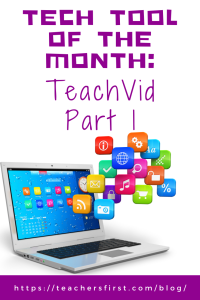TeachVid is a web-based tool that helps students learn and practice English and world languages. The site uses thousands of ready-made resources, including interactive videos (with transcripts and translations), printable PDFs to go along with the videos, engaging reviews and assessments. It also offers more features. You can search resources by the language the student speaks, the language of the video, the category of the video, difficulty level, and more. The free account allows unlimited use of the 1,000+ resources already available at TeachVid. It also allows educators to create five of their own video projects that can include engaging questions and additional extension activities.
Applying the Triple E Framework
The Triple E Framework, created by Dr. Liz Kolb, believes that “effective technology integration begins with good instructional strategies and not fancy tools” (tripleeframework.com). Dr. Kolb wrote a book on the topic, Learning First, Technology Second (ISTE, 2017), that lays out the three main uses for technology in education: to Engage, Enhance, or Extend learning goals. We can use this framework to decipher why we use specific classroom tools. Here is a rubric based on the Triple E Framework you can use to evaluate whether TeachVid (or any other technology) is a good fit with your learning goals and whether you should use it in your lesson.
- Engage in learning goals: The students are motivated to begin learning as TeachVid allows them to complete the listening comprehension videos and activities through the engagement of game-based learning. TeachVid helps students focus on the content (learning goals) with minimal distractions, as there are no advertisementson the website. The students are active rather than passive learners who can independently view the videos and activities on the website rather than just read a textbook.
- Enhance learning goals: TeachVid creates paths for students to demonstrate their understanding of the learning goals in a way they cannot do without technology. For example, students can view videos and answer engaging questions in multiple languages.
- Extend learning goals: As Dr. Kolb describes, extended learning is an opportunity for students to learn, connect, and collaborate outside the regular school day and to create a bridge between school learning and everyday life experiences. TeachVid would make an ideal asynchronous learning experience, as students could complete the practice videos at home, assigned by the teacher.
SAMR Connection
The SAMR Model, by Dr. Ruben Puentedura, suggests that technology implementation has four levels. Therefore, we can use this model as a guideline to analyze how we use technology tools in the classroom. For example, using TeachVid with your students could be at the levels of Substitution and Augmentation.
- Substitution: The substitution level is the most basic level of SAMR and refers to when technology acts as a direct substitute without any functional improvements. An easy substitution example is if students watch and listen to the video/story on the TeachVid site instead of the teacher sharing the story in class.
- Augmentation: At the level of augmentation, the technology acts as a direct substitute and includes some functional improvements. TeachVid allows students to replay the video or use the dial to slow the speech; you can also differentiate between 9 difficulty levels and 18 languages.
Please take advantage of Part 2 of the Tech Tool of the Month: TeachVid, where we’ll discuss using the tool and classroom ideas. In the meantime, let us know how you have used TeachVid in your education setting in the comment section below.


